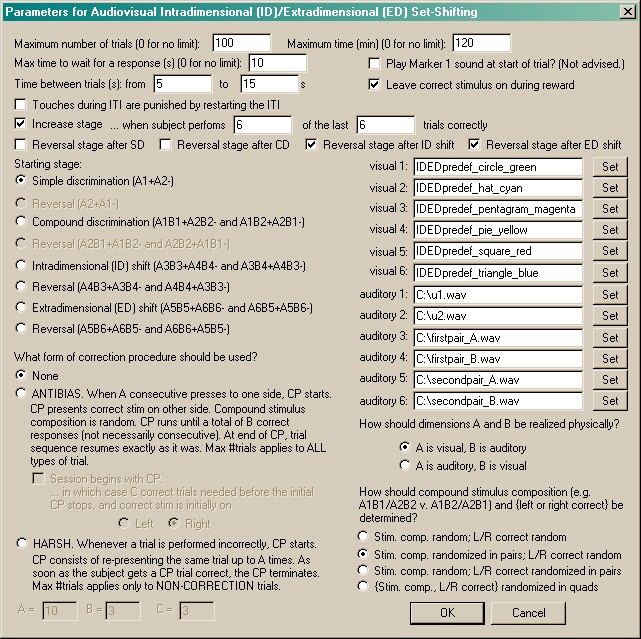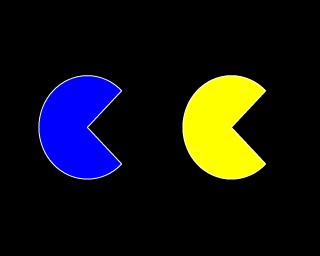A rat attentional set-shifting task in which one stimulus dimension is auditory, and one visual. Stimuli are presented to the left or right of the chamber - so a "left" compound stimulus is a visual stimulus on the left-hand side of the screen, and an auditory stimulus from the left-hand speaker.
For details of the principles of intradimensional and extradimensional attentional set-shifting, see About Set-Shifting.
Configuring the task
Note: changes by John Earl (August 2005, RatBat v1.3) not yet documented.
This task involves stereo auditory discrimination. Therefore, to run, both "Stereo system..." and "Subject is considered to have responded to a stimulus when it... approaches it" must be selected in the General Parameters.

| • | Maximum number of trials. When the subject has performed this number of trials, the task ends. (You may specify 0 for no limit, though you must specify a limit on the number of trials, the time, or both.) |
| • | Maximum time. When this time elapses, the task is terminated as soon as the current trial has finished. (You may specify 0 for no limit, though you must specify a limit on the number of trials, the time, or both.) |
| • | Maximum time to wait for a response. If the subject fails to make a response within this time, the subject fails the trial. |
| • | Play Marker 1 sound at start of trial? Fairly obvious. |
| • | Time between trials. Specify a minimum and a maximum intertrial time (they may be the same). The actual time is chosen with a rectangular probability distribution within these values. The time between trials starts after the reward or punishment from the previous trial has finished. |
| • | Leave correct stimulus on during reward. If unticked, all stimuli vanish when one is chosen. If ticked, then if the incorrect stimulus is chosen both vanish; if the correct stimulus is chosen, the incorrect stimulus vanishes and the correct stays for a while (while reward is being delivered). |
| • | Increase stage... when subject performs X of the last Y trials correctly. Fairly obvious, I hope. Set the value of X and Y in the boxes. |
| • | Give a reversal stage after the simple discrimination. Enables/disables the "SD reversal" phase. |
| • | Give a reversal stage after the compound discrimination. Enables/disables the "CD reversal" phase. |
| • | Give a reversal stage after the ID shift. Enables/disables the "ID reversal" phase. |
| • | Give a reversal stage after the ED shift. Enables/disables the "ED reversal" phase. |
| • | Starting stage. Choose the stage to start at for this session. |
| • | Correction procedure. Choose the type of correction procedure you wish to use. The meaning of the types of correction procedure is explained carefully in the dialogue box. Note that if your subject shifts up a stage, any ongoing correction procedure is cancelled, and all correction procedure counts are reset. |
| • | Stimuli. Choose the stimuli required by the task (visual 1, visual 2, auditory 1, auditory 2, etc.). An example is shown above. |
| • | Physical realization of dimensions A and B. Dimensions A and B (as referred to in the stages shown on the left) can be assigned such that A=visual, B=auditory, or the other way round. |
| • | Randomization. Choose the randomization technique used for the task. For compound stimuli, in any given trial you can present either A1B1 / A2B2 compounds, or A1B2 / A2B1 compounds. Furthermore, the correct stimulus can be on the right or on the left. The stimulus composition and the "left/right correct" assignment can be fully random (with a very small chance that you get ten on the left consecutively correct, because that's what random means). Or, the "left/right correct" assignment can be randomized in pairs (meaning that in pair of trials you get one "left correct" trial and one "right correct" trial, e.g. L,R - R,L - R,L - L,R - R,L - R,L - R,L - ...), with the stimulus composition totally random. Or the stimulus composition can be randomized in pairs (e.g. A1B1[/A2B2], A1B2[/A2B1] - A1B2[/A2B1], A1B1[/A2B2] - A1B2[/A2B1], A1B1[/A2B2] - ...) with the L/R assignment fully random. Or the four possible combinations (L versus R correct and A1B1/A2B2 versus A1B2/A2B1) can be randomized in groups of four trials (quads). |
Screenshots from the task
Screenshots are not terribly informative, since this is a combined audiovisual task! But two stimuli are shown on the screen, so it could look like this:
Choose one. But maybe you should be listening, rather than looking...
